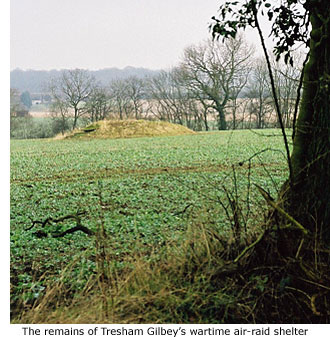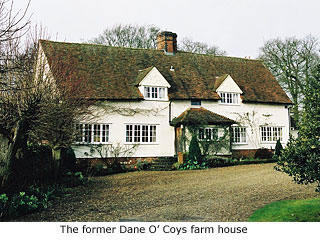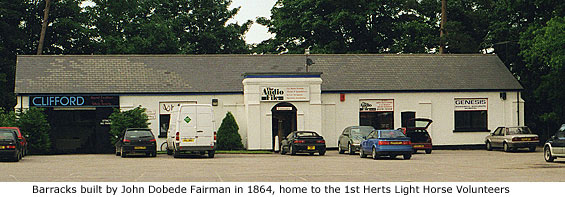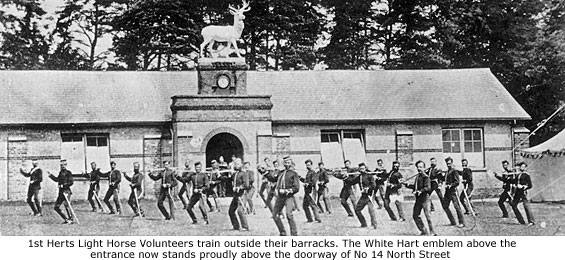|
 Dane O’ Coys Lane links Hadham Road with Cricketfield Lane and then continues as a narrow route (named just 'Dane O’ Coys') that eventually leads to Whitehall and Whitehall Lane. How the name ‘Dane O’ Coys’ originated is a mystery even to local historians – 19th century documents referring to it as 'Denny Coys' and 16th century documents as 'Dene a Coy' – but it is likely to have derived from a local person (possibly Edward Denny – See Guide 10) as there was a farm here by that name in the 16th century. That said, here are a few other possibilties as to how the name may have come about, passed on to me by Clavering historian Jacqueline Cooper. Dane O’ Coys Lane links Hadham Road with Cricketfield Lane and then continues as a narrow route (named just 'Dane O’ Coys') that eventually leads to Whitehall and Whitehall Lane. How the name ‘Dane O’ Coys’ originated is a mystery even to local historians – 19th century documents referring to it as 'Denny Coys' and 16th century documents as 'Dene a Coy' – but it is likely to have derived from a local person (possibly Edward Denny – See Guide 10) as there was a farm here by that name in the 16th century. That said, here are a few other possibilties as to how the name may have come about, passed on to me by Clavering historian Jacqueline Cooper.
In 1303 John de Coye or Queye owned a manor in Hatfield Peverel, Essex. Queye was possibly a French name, perhaps of Norman origin, and the family may well have owned or been granted land in Bishop's Stortford.
And from the notes of Bishop's Stortford's foremost historian J.L. Glasscock (held at Bishop's Stortford Museum) comes the following:
A deed witness in 1465 was John Dane at Coyses, with John Dam in occupation; 1614 deeds mention 'lane or streate called Nokestreat leading from Dane at Coyves to Rye streat' (possibly present day Dane O' Coys); and in 1640 there is record of a sidesman at the church called John Gladwin of Dane-at-Coyves. In 1648 Dennycoys was the property of Thomas Miller called Dam at Coves.
 The property referred to was most likely the 16th century farmhouse of Dane O' Coys Farm that continued to operate well into the 20th century. Now privately owned, the house still stands in Dane O' Coys just beyond the junction with Cricketfield Lane. The property referred to was most likely the 16th century farmhouse of Dane O' Coys Farm that continued to operate well into the 20th century. Now privately owned, the house still stands in Dane O' Coys just beyond the junction with Cricketfield Lane.
In his notes, J.L. Glasscock refers to the farm as 'Dennycoys' and states it has no history. Unfortunately the name is not discussed in either The Victorian History of the Counties of England Hertfordshire, or in Place Names of Hertfordshire.
Up until 1947 this entire area was part of the vast Whitehall estate owned by Tresham Gilbey, who, to safeguard his family during World War II, had a large air raid shelter built in a field near to his home. The remains of this shelter, in the form of a large grass mound, can still be seen from Dane O’ Coys opposite Rhododendron Walk – now a footpath but originally constructed as an ornamental carriage drive between Cricketfield Lane and Gilbey's home, Whitehall (See Guide 7). MORE PICTURES
|
|
At the top of Hadham Road is Silver Leys, an equally mysterious title given to an area of land that for over 130 years has been the site of many notable events in Bishop’s Stortford’s history, including recreational, sporting and military pursuits.
It was the venue of Bishop’s Stortford football club’s first ever match in 1874 (See Guides 6 & 10) and has been home to the town’s rugby club, on and off, since 1928. Formed in 1920, the club’s matches were first played at Dunmow Road where they made a promising start, but when they moved to this site eight years later their fortunes rapidly declined and the club was disbanded prior to World War II. Re-formed in 1950, fixtures were few and far between to begin with, most matches being played away against teams in North London. Any home matches were still played at Silver Leys, but as club funds made no allowance for changing facilities here, the team had to walk to the George Hotel in North Street where the supportive landlord allowed them use of his barn as a changing room. The current rugby club was re-established at Silver Leys in 1985.
In 1962, during preparation of a new playing field here, ‘worked flints’ were uncovered of a type made by Middle Stone Age or ‘Mesolithic’ people. From past evidence, such flints were known to have been used by hunter bands between 6,000 and 4,000 B.C.

Facing the entrance and car park is a long, single-storey building currently used as a commercial outlet, but in the 19th century this same building was home and barrack room of the town’s very own ‘regiment’. During the Napoleonic Wars (1793–1815) the threat of invasion to this country was instrumental in the Defence of the Realm Act, authorised by George III, which allowed the creation of Volunteer Associations for local defence.
Bishop’s Stortford raised a troop of Volunteer Infantry (Armed Association) in March 1798, and though they were disbanded in 1802 an establishment comprising of 200 men was re-formed in 1803. When the threat of invasion finally passed, this too was disbanded in 1809.
In 1830, however, there were demands for a revival of the yeomanry when large groups of labourers in southern England vented their anger against the establishment because inadequate wages didn't allow them to support their families. Rioting took place and after setting fire to many haystacks throughout the Home Counties they were given the name ‘Incendiarists’.
The yeomanry continued long after this event had passed and in 1862 an influential man in Bishop’s Stortford, John Dobede Fairman, set about raising a local force of volunteer cavalry who became known as the 1st Herts Light Horse Volunteers. The troops initially trained in a house at Windhill and after having their services accepted by Queen Victoria in November 1862, were among 17,000 volunteers chosen to parade in Hyde Park the following year to honour the Prince of Wales and Princess Alexandra of Denmark who were driving to Windsor for their wedding.
By the autumn of 1864 the troop, now 98 strong, were given authorisation to be increased to a squadron, and Fairman, who owned Silver Leys, had these barracks built for them. A prominent fixture above the entrance to the barracks was a large figure of the regiment’s stag (white hart) emblem.

Fairman, however, suddenly became less prominent in 1878 after being arraigned for bankruptcy. With debts in excess of £137,000 he is thought to have fled the country, and despite a reward of £500 being offered for his capture he was never heard of or seen again. The corps was disbanded the following year and though the barracks survived, the regimental stag figure was removed by a Major Holland and re-erected on the facade of his grocery store at No 18 North Street – later to become Holland and Barrett (See Guide 6).
Silver Leys was then bought by Sir Walter Gilbey who, at the celebration of Queen Victoria’s Diamond Jubilee in 1897, arranged sporting activities here and laid on tea and refreshment for 1600 local children. He later donated the land to the town, primarily for equestrian sports, and to Stansted Polo Club, of which his son Tresham was once captain and regularly played here in the early 1920s. Bishop’s Stortford’s annual Horticultural Show was also held here for a number of years after the death of Sir John Barker in 1915. Since its conception in the late 1800s to help raise funds for Bishop's Stortford's hospital, the event had been hosted by Sir John in the grounds of his Rye Street home (See Guide 7 – The Grange).
Directly opposite the entrance to Silver Leys stands Dane House, an imposing development that stems from the original Dane House built in 1905 by Sir John Barker for his daughter, Ann, and her husband Tresham Gilbey. Apparently, though, his daughter disliked the house so much that Sir John had Whitehall built for her instead (See Guide 7 – Whitehall). Dane House was then sold to private ownership and in November 1962 became the Dane House Hotel. Unable to fulfil its role this was partly demolished in 1986 and other buildings, in the same style, added to accommodate private apartments. MORE PICTURES
|



 Dane O’ Coys Lane links Hadham Road with Cricketfield Lane and then continues as a narrow route (named just 'Dane O’ Coys') that eventually leads to Whitehall and Whitehall Lane. How the name ‘Dane O’ Coys’ originated is a mystery even to local historians – 19th century documents referring to it as 'Denny Coys' and 16th century documents as 'Dene a Coy' – but it is likely to have derived from a local person (possibly Edward Denny – See Guide 10) as there was a farm here by that name in the 16th century. That said, here are a few other possibilties as to how the name may have come about, passed on to me by Clavering historian Jacqueline Cooper.
Dane O’ Coys Lane links Hadham Road with Cricketfield Lane and then continues as a narrow route (named just 'Dane O’ Coys') that eventually leads to Whitehall and Whitehall Lane. How the name ‘Dane O’ Coys’ originated is a mystery even to local historians – 19th century documents referring to it as 'Denny Coys' and 16th century documents as 'Dene a Coy' – but it is likely to have derived from a local person (possibly Edward Denny – See Guide 10) as there was a farm here by that name in the 16th century. That said, here are a few other possibilties as to how the name may have come about, passed on to me by Clavering historian Jacqueline Cooper.
